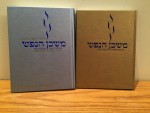This month, the Reform movement’s new High Holiday prayer book, Mishkan HaNefesh, is being published. It replaces Gates of Repentance, which has served the movement since 1978, and is a companion to the movement’s siddur, Mishkan T’filah, which was published in 2007.
“It was an innovative siddur in a number of ways,” Rabbi Hara Person, publisher and director of CCAR Press, the Central Conference of American Rabbis’ publishing division, told the Independent. “It includes a lot of poetry and other kinds of readings that haven’t historically been in prayer books. It includes both the faithful translation of the text alongside, in some cases, alternative translations.
“The approach is multi-focal. It’s not an approach that says there is only one way to read our tradition or prayer. Instead, it opens up to people different ways of understanding, and struggling and grappling, with the text and tradition … and with theology.”
As an example of the new machzor’s increased accessibility, Person explained that, as does Mishkan T’filah (Sanctuary of Prayer), Mishkan HaNefesh (Sanctuary of the Soul) includes transliteration throughout for all of the prayers. “We wanted it to be open and welcoming to people, no matter what their background or how much or little a Jewish education they have,” she said.
About the diversity of the people sitting in the pews, she added, “Some may not be Jewish at all. They might be there with a Jewish spouse or partner. We don’t want to tell them that there’s nothing there for them. We want them to be able to learn and participate to the extent that they’re comfortable.”
Another significant aspect of the machzor is its inclusivity. “For over 25 years,” said Person, “we’ve been speaking up about inclusion of gay and lesbians in our communities on every level, so this is just another piece of that. That’s true for anybody who walks through our doors.”
This meant that the language of some of the prayers had to be updated.
At the heart of the prayers that talk about a bride and groom, for example, is the love between a couple. “So, we changed the language to reflect that and to not exclude gay and lesbian couples,” said Person. “Also, regarding being called to the Torah, we felt it should reflect the view and acceptance of all people, including those struggling with gender identity … calling people from the ‘house of’ as opposed to referring to them as ‘the son or daughter of.’…”
These most recent changes follow those that have come before regarding the increased participation and recognition of women.
“I think the Reform movement has a long history of egalitarianism, even from the very start,” said Person. “Even before women were rabbis, the Reform movement did away with separate seating in synagogues, so very early on in the history of the Reform movement, men and women were allowed to sit together in synagogues.
“So, these are just further steps in that progression of treating everybody with dignity and with a sense of equality and inclusiveness, and a way of saying we are all created in the image of God … women as well as men. It’s true for gay or straight or trans. Why would we exclude some but not others? It’s part of our value system to be inclusive.”
The new machzor has been in the works for a long time.
“We did a tremendous amount of piloting ahead of time,” said Person. “The book was in development for five or six years. Over those years, we had about 350 congregations across North America who piloted different sections of it.”
Some other interesting features of the new machzor are the poetry – from American and also Israeli writers – and art.
“We worked with an artist in New York named Joel Shapiro,” explained Person. “He created an opening piece of art for each of the services. They are woodblock cuts. He spent a huge amount of time studying the services and prayers and was inspired to create the art for the services.
“For me,” she continued, “it’s really exciting because some people love poetry and that’s going to … be a way into the prayer book and into the experience of worship for them. For others, it will be the commentary, and for others still, it will be the art…. Art may open the door for them and help them walk in. It’s really exciting that we were able to do all these things within the prayer book.”
A large-print version of Mishkan HaNefesh will also be available, as will an e-book version. “There is a percentage of people who actually use machzors before the holidays to do their own spiritual preparation,” said Person. “This book has so much in it for that. For a tablet, maybe they’d use it ahead of time, but not bring it to synagogue. I don’t know.”
For more information about the new machzor, visit ccarpress.org.
Rebeca Kuropatwa is a Winnipeg freelance writer.

